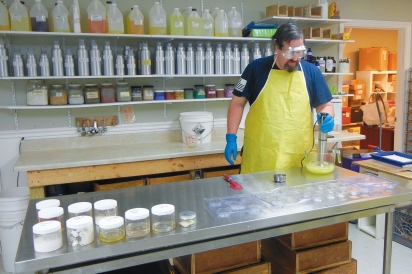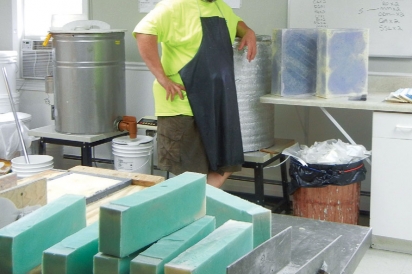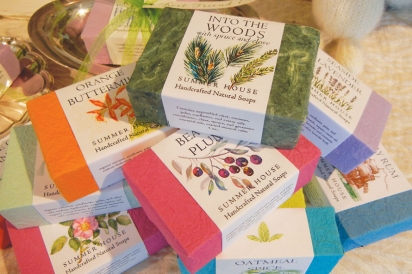Raising the Bar
When you pull into the Summer House Soaps parking lot, the scent is the first thing you notice. It’s an earthy, organic fragrance that comforts and embraces you. The parking lot alone may be worth the trip if you need to unwind.
Owner Ann Miller says, “There are three basic stories people have about how they got into soap making: they learned at the knee of their grandmother from the Black Forest, they were allergic to everything or they started out by making gifts in their kitchen.” Miller’s story is the last one. “I went through my Martha Stewart phase when my kids were little.” Initially she gave the soaps as gifts. From there the business grew incrementally. For 15 years she worked, first out of her home and then an old barn on her property.
Soap of one sort or another has been around for about five thousand years. A clay tablet from 2200 BCE found in a Babylonian excavation held a formula for fat (cassia oil) boiled with ashes (the alkali) to make a soap-like substance. A bit more recently, around 1550 BCE, ancient Egyptians, who were known to have bathed regularly, combined animal and vegetable oils with alkaline salts as noted on the Ebers Papyrus. In the reign of Nabonidus, the last king of Babylonia from 556–539 BCE, a recipe for soap was discovered consisting of uhulu (ashes), cypress oil and sesame seed oil “for washing the stones for the servant girls”. Ancient Romans rubbed olive oil on their skin, then scraped it and the dirt off with a knife called a strigil and then hopped into a “hot tub” to conclude the cleanse.
“Soapman Fred” Carpenter loves what he does. He and his wife are Medievalists who “messed around making cheese and soaps” long before he came to Summer House Soaps four years ago. He is a maker by trade and in his spare time makes knives out of reclaimed metal, their handles out of exotic scrap woods such as ebony for his business, Cape Cod Cutlery.
Carpenter makes up to two thousand bars a week in the summer and again around the holidays, when gift-giving demand is up. January to March is expectedly quieter. The holiday gift orders come from all over the country and sometimes the world. As Miller says, “The Cape is a great place to grow a business, as the sizable online base is largely from people who have physically visited the shop.”
The soapmaking process commences when a combination of six oils—organic olive oil, coconut oil, sunflower oil, palm oil, castor oil and cocoa butter—is poured into a 40-gallon vat and heated up to 100 degrees Fahrenheit. The oil mixture is then decanted into five-gallon buckets, where the mixing will take place. Lye and water are mixed separately and then added to the oil buckets. Lye is extremely caustic, a highly alkaline salt at nearly 14 on the pH scale. It arrives in salt-like crystal form and must be dissolved in water before making the soap. Safety glasses are worn at all times during the entire process; even demonstration attendees wear them (and an apron) in case of spatter.
Mineral pigments are added next. If botanicals and dried flowers are being used, they are added before the lye. Saponification, the chemical reaction between the acidic oil and alkaline lye mixture as the mixture is stirred, can turn the flowers brown or even black. The outcome, soap—three soap molecules to every one glycerin molecule—results in a 25% glycerin product. Most commercial soaps remove the glycerin because it makes the bars a little sticky, however, glycerin is better for skin because it makes the soap milder and more moisturizing.
The blend is stirred until a “trace” occurs. A trace is a drizzle dropped onto a plate from a spoon that sets up across the surface, just like making candy or fudge. It resembles nothing more than a good yellow cake batter or vanilla pudding. Any fragrances, if they are to be used, are then added.
The resulting mixture is poured into thirteen 30-pound wooden molds lined with wax paper and allowed to sit for three to five days to set and shrink a bit. Each wooden mold produces seven logs, each of which is hand cut with a wire cheese cutter into 11 slices, each weighing five ounces. The soaps are stacked on drying trays for six to eight weeks with fans whirling day and night to dry and shrink further prior to wrapping.
After maximum drying and shrinkage has occurred, the bars are boxed and stored in a room fitted with dehumidifiers until needed. Employees take the boxes home to hand cut the beautiful colorful handmade papers, and wrap and label the bars.
Summer House Soaps has recently switched to all organic oils and the base is comprised of coconut oil, sustainably-harvested palm oil, sunflower, extra-virgin olive oil and castor oil. You could eat this mixture! Shea butter and coco butter disks are used for the ultrasensitive bars with no colors or added botanicals. The soapmakers regularly use essential oils because it is laborious (and often cost prohibitive) to get flower fragrances. For example, 15,000 pounds of roses are needed to produce one ounce of rose oil! Seventy-five percent of their soaps are scented with essential oils, which provide aromatherapy benefits as well as antibacterial and antifungal properties. Carpenter adds goat milk to some of the soaps. He has made soap with wine and beer and often oatmeal for soothing purposes. Speaking of beer, Summer House shares the parking lot with Cape Cod Beer, and Miller conveniently schedules the soap making demonstrations at 10:30 a.m., a half hour before the brewery tour.
Other add-ons or add-ins include cinnamon for color and scent, charcoal for an acne soap, bentonite clay for foamy shaving soap, kelp for exfoliation, calendula, lavender, or anti-inflammatory “sea clay” which has mineral-rich sea clay and kelp. The add-ins can change the production time. For example, adding clove oil can accelerate trace and quickly seize the soap mixture so a very close watch must be taken.
Miller sometimes falls in love with essential oils that are just too expensive to use in soap; woodsy scents like palo santo and oud. “Someday I’d like us to do an all-natural fragrance line where we can play around with some of those super-expensive oils. Perfumes only require a few drops of oil, whereas each batch of soap takes almost a pound.” Oud, or agarwood, is one of the most popular scents on the market today and is said to be the most expensive wood in the world; oud oil is estimated to be 1.5 times the value of gold. Palo santo, a South American tree related to frankincense, is not as costly as oud but is still out of range for the pound that would be needed per batch of soap.
They’ve recently added vetiver, a perennial bunchgrass native to India that has a woodsy-smoky scent, to many of their blends. It smells wonderful, grounds the blend and keeps it from fading. Miller says, “We sometimes sneak in a little patchouli oil for the same reason, but it has to be subtle. Some people really don’t like patchouli.”
After a trip to Tanzania and spending some time in Zanzibar, Miller dreamed of creating a soap that reminded her of the trip and the African spices she both smelled and consumed. Her dream resulted in the Zanzibar Isle soap, which contains cinnamon, clove, rosewood, cardamom, cedar, lemongrass, black pepper essential oils and a touch of nutmeg.
The Summer House Soaps blend of oils is slightly “super-fatted”, meaning an additional three percent of the oils is added to provide a margin of error against having too much lye. Excess lye would make the soap too harsh. Each oil in their blend adds a different characteristic according to its fatty acid profile: olive oil is moisturizing but doesn’t lather well; coconut oil lathers especially well and is an antioxidant, but it can also be drying; palm oil makes the bar hard; castor oil makes the lather silky.
Miller’s joyful enthusiasm and marvel for her business is expressed in her parting words to me. “The thing about soap is, that it is a transformation—as crafts go—it is kitchen chemistry as well as a challenge. The appeal lies in the combining of greasy fat and caustic lye and out comes a beautiful and useful product.”
Summer House Soaps
1336 Phinneys Lane, Hyannis 508-827-4145 / summerhousesoaps.com








